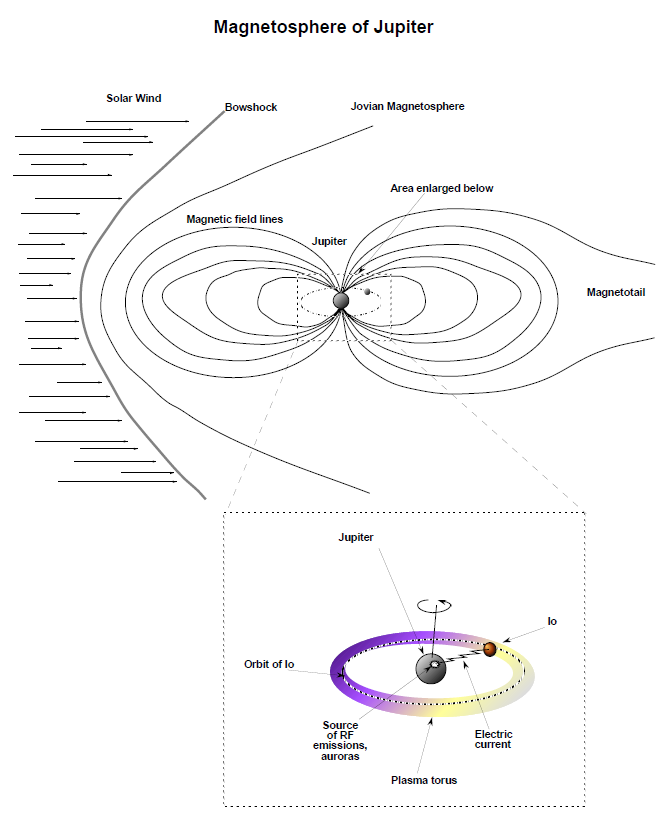


 الفيزياء الكلاسيكية
الفيزياء الكلاسيكية
 الكهربائية والمغناطيسية
الكهربائية والمغناطيسية
 علم البصريات
علم البصريات
 الفيزياء الحديثة
الفيزياء الحديثة
 النظرية النسبية
النظرية النسبية
 الفيزياء النووية
الفيزياء النووية
 فيزياء الحالة الصلبة
فيزياء الحالة الصلبة
 الليزر
الليزر
 علم الفلك
علم الفلك
 المجموعة الشمسية
المجموعة الشمسية
 الطاقة البديلة
الطاقة البديلة
 الفيزياء والعلوم الأخرى
الفيزياء والعلوم الأخرى
 مواضيع عامة في الفيزياء
مواضيع عامة في الفيزياء|
Read More
Date: 24-2-2016
Date: 24-8-2020
Date: 18-8-2020
|
The Jupiter System
By far the most interesting planet for radio astronomy studies is Jupiter. As beautiful and fascinating as it is visually, it is even more fascinating and complex to observe in the radio frequency range. Most of the radiation from the Jupiter system is much stronger at longer wavelengths than would be expected for thermal radiation. In addition, much of it is circularly or elliptically polarized not at all typical of thermal radiation. Thus, it must be concluded that non-thermal processes similar to those taking place in galaxies are at work. That is, ions and electrons accelerated by the planet’s spinning magnetic field are generating synchrotron radiation.
Jupiter is 318 times as massive as Earth. Its magnetic axis is tilted 15° from its rotational axis and offset from the planet’s center by 18,000 km. Its polarity is opposite that of Earth (that is, a compass needle would point south.(
Jupiter’s surface magnetic field is 20 to 30 times as strong as that of Earth. The magnetosphere of a planet is the region around it in which the planet’s magnetic field dominates the interplanetary field carried by the solar wind. If we could see Jupiter’s magnetosphere from Earth, it would appear as large as our moon!
The farther a planet is from the sun, the weaker will be the pressure from the solar wind on the planet’s magnetosphere. Thus, Jupiter’s magnetic field, already quite intense, has considerably less pressure holding it close to the planet than does Earth’s magnetic field. Jupiter’s magnetosphere expands and contracts with variations in the solar wind. Its upstream (closest to the sun) boundary (called the bowshock) varies from 50 to 100 Jupiter radii and envelopes Jupiter’s four large Galilean satellites. (Sixteen Jupiter satellites have been discovered; the Galilean satellites are by far the largest).
The magnetosphere of a planet traps plasma, as magnetic lines of force catch protons and electrons carried on the solar wind and atoms that escape upward from the planet’s atmosphere. In the case of Jupiter, since the magnetosphere is so large, it also traps atoms from the surfaces of the satellites orbiting within it. Io, the innermost Galilean satellite, is an especially rich source of oxygen and sulfur ions from its many violently active volcanoes. Io is estimated to contribute 10 tons of material to the magnetosphere per second!

As a matter of fact, a predominant feature of Jupiter’s magnetosphere is the plasma torus that surrounds the planet, corresponding closely with the orbit of Io, which is at about five Jupiter radii. It is an intensely radiating plasma within a slightly less active outer plasma. To add to the adventure, as Io orbits through the magnetic field lines, an electric current of up to 5 million Amps is generated between Io and the planet! Where this current reaches the atmosphere of Jupiter, it generates strong radio frequency emissions that can be associated with the orbital position of Io. The current also generates auroras in the upper atmosphere of Jupiter.
The Goldstone-Apple Valley radio telescope will be used to measure time variable radio frequency emissions from Jupiter’s magnetic field. These observations can provide new information about the magnetosphere, the plasma torus, and the rotation of Jupiter’s core and how it differs from the rotation of the visible atmosphere.



|
|
|
|
دخلت غرفة فنسيت ماذا تريد من داخلها.. خبير يفسر الحالة
|
|
|
|
|
|
|
ثورة طبية.. ابتكار أصغر جهاز لتنظيم ضربات القلب في العالم
|
|
|
|
|
|
|
العتبة العباسية المقدسة تستعد لإطلاق الحفل المركزي لتخرج طلبة الجامعات العراقية
|
|
|